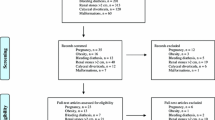Abstract
Ureteroscopic management of urolithiasis in pregnancy has been on the rise. Technological advancements such as the development of the semi-rigid or flexible ureteroscope, improvements in the design of baskets used for retrieval and the availability of laser have enabled atraumatic fragmentation of stones. We did a systematic review of literature from January 1990 to December 2012. Data were analysed separately for the time period from January 1990 to June 2010 (Period 1) and for last 2.5 years from July 2010 to December 2012 (Period 2). Inclusion criteria were all English language articles with at least three patients reported. Data were extracted on the outcomes and complications reported in the literature. A total of 271 procedures (116 in period 1, 155 in period 2) across 21 studies were reported in the last 22 years. General anaesthesia was used in 38 % (44/116) in period 1 and in 64 % (99/155) in period 2. The average stone size (7.6 mm) and stone-free rate (SFR) (85 %) were similar in both time periods. Fluoroscopy was used in 20 % (23/116) and 24 % (38/155) in period 1 and 2, respectively. There were fewer complications in period 1 (n = 9) than period 2 (n = 25). These complications were divided into obstetric (n = 5) and non-obstetric complications (n = 29). There were no maternal or foetal deaths during the 22 years. Stone treatment using ureteroscopic techniques in pregnancy can achieve a high success rate. Evidence suggests a rise in the risk of complications with increasing number of these procedures in pregnancy.

Similar content being viewed by others
References
Khoo L, Anson K, Patel U (2004) Success and short-term complication rates of percutaneous nephrostomy during pregnancy. J Vasc Interv Radiol 15:1469–1473
Drago JR, Rohner TJ Jr, Chez RA (1982) Management of urinary calculi in pregnancy. Urology 20:578–581
Gorton E, Whitfield H (1997) Renal calculi in pregnancy. Br J Urol 80(suppl 1):4–9
Rodriguez PN, Klein AS (1988) Management of urolithiasis in pregnancy. Surg Gynecol Obstet 166:103–106
Cormier CM, Canzoneri BJ, Lewis DF, Briery C, Knoepp L, Mailhes JB (2006) Urolithiasis in pregnancy: current diagnosis, treatment, and pregnancy complications. Obstet Gynecol Surv 61(11):733–741
Swanson SK, Heilman RL, Eversman WG (1995) Urinary tract stones in pregnancy. Surg Clin N Am 75:123–142
Biyani CS, Joyce AD (2002) Urolithiasis in pregnancy. I: pathophysiology, fetal considerations and diagnosis. BJU Int 89:811–818
Biyani CS, Joyce AD (2002) Urolithiasis in pregnancy II: management. BJU Int 89:819–823
Swanson SK, Heilman RL, Eversman WG (1995) Urinary tract stones in pregnancy. Surg Clin N Am 75:123–142
Pais VM Jr, Payton AL, LaGrange CA (2007) Urolithiasis in pregnancy. Urol Clin North Am 34:43–52
Srirangam SJ, Hickerton B, Van Cleynenbreugel B (2008) Management of urinary calculi in pregnancy: a review. J Endourol 22:867–875
Laing KA, Lam TB, McClinton S, Cohen NP, Traxer O, Somani BK (2012) Outcomes of ureteroscopy for stone disease in pregnancy: results from a systematic review of the literature. Urol Int 89(4):380–386
OCEBM levels of evidence working group. The Oxford levels of evidence 1. Oxford Centre for Evidence-Based Medicine (2011). http://www.cebm.net/index.aspx?o=1025
Peake SL, Roxburgh HB, Langlois SL (1983) Ultrasonic assessment of hydronephrosis of pregnancy. Radiology 146:167–170
Roberts JA (1976) Hydronephrosis of pregnancy. Urology 8:1–4
Gabert HA, Miller JM (1985) Renal disease in pregnancy. Obstet Gynecol Surv 40:449–461
Maikranz P, Lindheimer M, Coe F (1994) Nephrolithiasis in pregnancy. Baillieres Clin Obstet Gynaecol 8(2):375–386
Lu Z, Dong Z, Ding H, Wang H, Ma B, Wang Z (2012) Tamsulosin for ureteral stones: a systematic review and meta-analysis of a randomized controlled trial. Urol Int 89:107–115
Parulkar BG, Hopkins TB, Wollin MR et al (1998) Renal colic during pregnancy: a case for conservative treatment. J Urol 159:365–368
Harris RE, Dunnihoo DR (1967) The incidence and significance of urinary calculi in pregnancy. Am J Obstet Gynecol 99:237–241
Hendricks SK, Ross SO, Krieger JN (1991) An algorithm for diagnosis and therapy of management and complications of urolithiasis during pregnancy. Surg Gynecol Obstet 172:49–54
Swartz MA, Lydon-Rochelle MT, Simmon D, Wright JL, Porter MP (2007) Admission for nephrolithiasis in pregnancy and risk of adverse birth outcomes. Obstet Gynecol 109:1099–1104
Boridy IC, Maklad N, Sandler CM (1996) Suspected urolithiasis in pregnant women: imaging algorithm and literature review. AJR Am J Roentgenol 167:869–875
McAleer SJ, Loughlin KR (2004) Nephrolithasis pregnancy. Curr Opin Urol 14:123–127
Türk C, Knoll T, Petrik A, Sarica K, Straub M, Seitz C (2012) Guidelines on urolithiasis. European Association of Urology, Arnhem
Elgamasy A, Elsherif A (2010) Use of Doppler ultrasonography and rigid ureteroscopy for managing symptomatic ureteric stones during pregnancy. BJU Int 106(2):262–266
Polat F, Süleyman Y, Kiraç M, Biri H (2011) Treatment outcomes of semirigid ureterorenoscopy and intracorporeal lithotripsy in pregnant women with obstructive ureteral calculi. Urol Res 39(6):487–490
Bozkurt Y, Penbegul N, Soylemez H, Atar M, Sancaktutar AA, Yildirim K, Erdal Sak M (2012) The efficacy and safety of ureteroscopy for ureteral calculi in pregnancy: our experience in 32 patients. Urol Res 40(5):531–535
Isen K, Hatipoglu NK, Dedeoglu S, Atılgan I, Çaça FN, Hatipoglu N (2012) Experience with the diagnosis and management of symptomatic ureteric stones during pregnancy. Urology 79(3):508–512
Hoscan MB, Ekinci M, Tunçkıran A, Oksay T, Özorak A, Özkardes H (2012) Management of symptomatic ureteral calculi complicating pregnancy. Urology 80(5):1011–1014
Johnson EB, Krambeck AE, White WM, Hyams E, Beddies J, Marien T, Shah O, Matlaga O, Pais VM Jr (2012) Obstetric complications of ureteroscopy during pregnancy. J Urol 188(1):151–154
Conflict of interest
The authors declare that they have no conflict of interest.
Author information
Authors and Affiliations
Corresponding author
Rights and permissions
About this article
Cite this article
Ishii, H., Aboumarzouk, O.M. & Somani, B.K. Current status of ureteroscopy for stone disease in pregnancy. Urolithiasis 42, 1–7 (2014). https://doi.org/10.1007/s00240-013-0635-y
Received:
Accepted:
Published:
Issue Date:
DOI: https://doi.org/10.1007/s00240-013-0635-y



